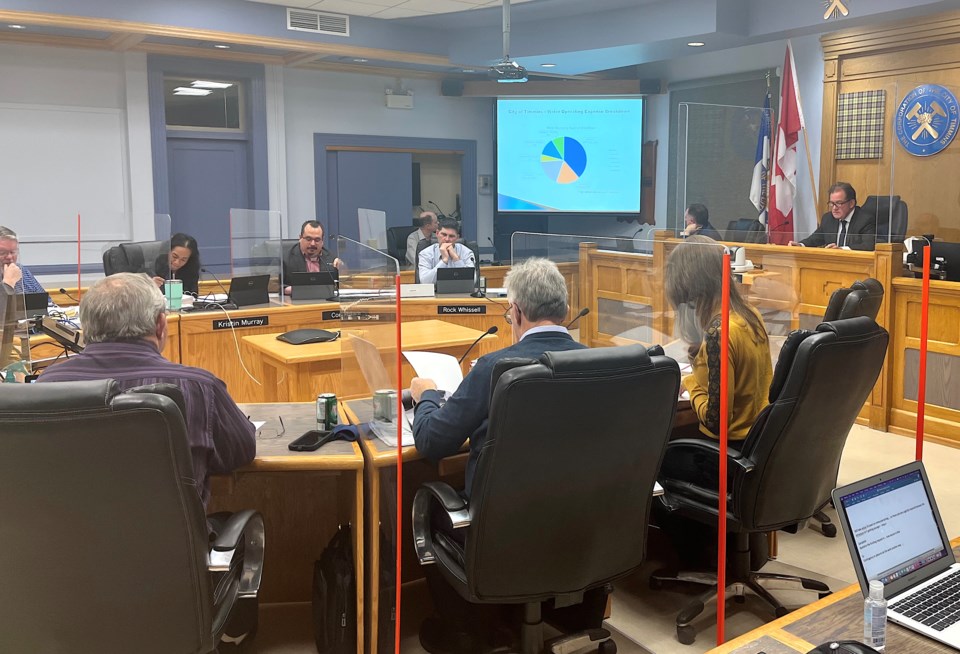City council members rehashed discussions on the existing 10-year plan for water and sewer user fees Wednesday night.
Timmins Council hosted its first in a series of 2022 budget meetings. Members received the first draft of the water and wastewater budget. The total expenditure for water works is $13,143,800. The total expenditure for wastewater works is $17,570,848.
During the budget presentation, one councillor raised questions about the water and sewer rates. The document showed an average flat rate increase of $53, with $22 going to the water side and $31 to wastewater. Last year, rates went up by $50. In 2023, the plan calls for an increase of $56. Rates continue to jump until 2030, where the average hike is $83.
There was a rebate program in place for low-income homeowners last year. A $50 rebate was claimed by 111 residents. Discussions took place about increasing the rebate.
Coun. Joe Campbell said with inflation rates increasing nationwide, not everyone can afford constant increases in these rates.
“A lot of our residents are low-income earners,” Campbell said. “We don’t have to accept a 5.3 per cent increase. I’m not in favour of 5.3, 5.3, 5.3 (every year).
“That’s 61 per cent in compounded interest.”
He added that the rebate program was essentially “giving them back their own money.”
Coun. Cory Robin said increases are needed because the city was saddled with a deficit for water and sewer, and infrastructure still has to be maintained.
“Infrastructure is crumbling all over the place... and that money is not coming from thin air,” Robin said. “The 10-year plan in place puts us on a stable level.
“Water and wastewater costs X amount. For years, the city charged less than X. That’s why we have a deficit... I support the 10-year plan, it’s the right choice for us.”
Veteran Coun. John Curley said at one time water and sewage fees were built into the regular property tax bills, instead of user fees. Provincial regulations changed and it was removed from the tax bill. To keep fees low, improvements fell behind, which eventually led to emergency situations.
“We’ve seen roads closed where infrastructure failed,” Curley said. “That is going to break us. It involves huge costs, we have to hire contractors (on an emergency basis).
“We need to keep costs down as low as we can and keep doing work. If we were raising fees and not improving, then it’s wrong. I see the work being done. We’re going in the right direction.”
Mayor George Pirie said catching up with infrastructure improvements and maintenance, particularly the lining program for both water and wastewater, is vital for the city.
“Water and wastewater are better managed than they have been,” he said. “I know how irritated residents are when they get the bill for a sewer backup the city isn’t covering.
“We know that we have a big job in front of us in water and wastewater. We’ve got to do a better job there … We haven’t been successful in spending the capital we want … If we want to reduce that deficit, we need to get those jobs done.”
Since 2018, the city has lined 5.6 km of its watermains. According to the report, this represents 2.5 per cent of Timmins’ 220 km of watermains.
Since 2018, the city has lined 11.4 km of wastewater mains. This represents 6.1 per cent of Timmins 187 km of wastewater mains.
Major projects budgeted for water in 2022 include:
- $2.35 million for watermain relining;
- $1 million for the Crawford watermain installation (with an application filed for the project that could get $733,300 in provincial funds);
- $1.1 million on connecting link infrastructure; and
- $250,000 for the water needs study.
Major projects budgeted for wastewater in 2022 include:
- $3.08 million for upgrades to the McIntyre pump station;
- $110,000 for upgrades to Bob’s Lake Lagoon;
- $1 million for wastewater lining;
- $640,000 for connecting link infrastructure;
- $500,00 for wastewater repairs; and
- $250,000 for a wastewater needs study.
The water and wastewater budget will be brought back to council on Dec. 14 for further review and discussion.
